South Africa is a land of exceptional natural beauty and diversity, not least because of the vibrant tapestry of birdlife that adorns its skies, forests, and grasslands. With a wide range of habitats including savannahs, wetlands, and coastal regions, it’s no surprise that this part of the world is home to an astonishing variety of winged wonders. In this article, I highlight some of the most common birds you can encounter throughout Southern Africa.
Whether you’re an avid birder or simply curious about South Africa’s avian inhabitants, you’ll discover fascinating insights into the lives of at least 19 bird species that thrive across this dynamic landscape, including that one with the funny name; the Go-Away-Bird 🙂
1. The Sociable Weaver: Community Architect of the Skies
Physical description:
- Small passerine bird with a distinct black chin
- Fluffy, brown and buff plumage with a scalloped back
- Body length: approximately 14 cm; wingspan: around 20 cm

The Sociable Weaver says it in the name: its colonial nesting behavior is widely seen in the Kalahari Desert, making it a common bird in Southern Africa. These weavers construct massive communal nests, mostly on telephone poles and acacia trees, each capable of housing hundreds of birds.
The complex structure of their nests allows for temperature control, keeping residents cool in the scorching heat and warm during cold nights.
Its Latin name is ‘Philetairus socius‘, which exemplifies cooperation in the animal kingdom, demonstrating how a shared environment can promote survival.
2. The Cape Sparrow: The Ubiquitous Urban Dweller – Passer Melanurus
Physical description:
- Small, robust body for city life
- Males sport a striking black head and chestnut shoulders; females are plainer
- The average size of 14-16 cm and weighs around 24-39 g
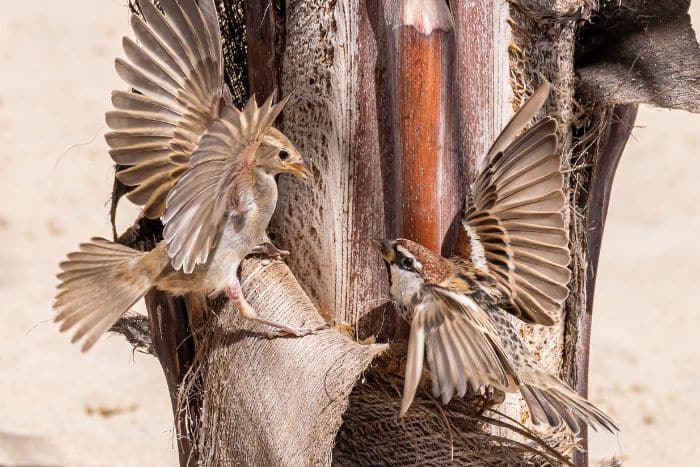
This very common bird thrives in suburban gardens, farms, and streets, is sociable, and is often seen in small flocks.
It is an opportunistic feeder and adapts its diet to its surroundings from seeds to scraps.
The Cape Sparrow’s (Passer Melanurus is the Latin name) ability to flourish in ever-changing urban environments is a testament to its adaptability. This species has perfected the art of living alongside humans, making the most of the resources we often overlook.
3. The Go-Away-Bird: Nature’s Sentimental Siren
Physical description:
- Medium size, mostly grey plumage, and a distinctive crest.
- Height: Around 50 cm tall.
- Weight: Approximately 230 grams.
- Colors: Predominantly grey with white-tipped tails and black facial markings.
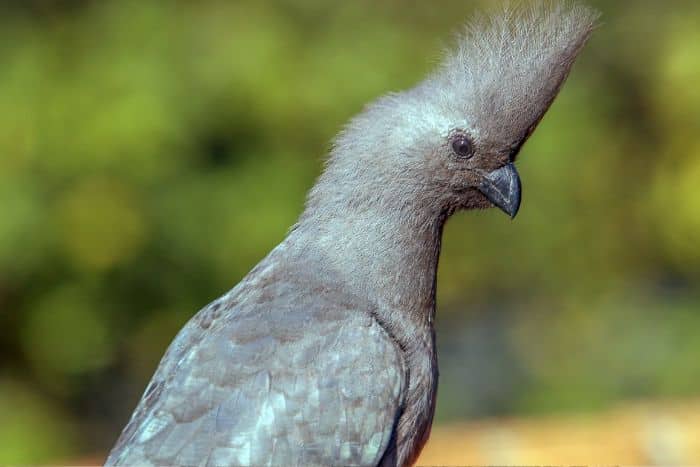
The Go-Away-Bird ( Corythaixoides Concolor ), with its pointed crest and soft grey tones, stands as a watchful sentinel in the South African landscapes, woodlands, savannas, and suburban gardens.
You can often spot it perched on high vantage points, diligently scanning the area for any signs of trouble.
Unlike other birds that might tweet or sing melodiously, the Go-Away-Bird issues a distinctive call that sounds remarkably like a petulant ‘go away’, especially when predators are nearby. This alert system earns the bird respect and a sort of guardianship status among the creatures of its habitat.
The call of the Go-Away-Bird, can you hear it? 🙂
4. The African Penguin: An Endearing Endangered Species
Physical description:
- Small stature with distinctive black and white plumage, known for their waddling gait and charismatic demeanor.
- African penguins, aka Jackass penguins, are typically about 60 to 70 centimeters (24 to 28 inches) tall and weigh between 2.2 to 3.5 kilograms (4.9 to 7.7 pounds)

Native to coastal southern Africa; this bird breeds on islands and some mainland beaches, with notable colonies on Boulders Beach and Robben Island.
Listed as Endangered on the IUCN Red List; populations are suffering due to overfishing, oil spills, and climate change.
The African Penguin has a unique adaptation: unlike most birds with waterproof plumage, these penguins have a layer of fat and tightly packed feathers to stay warm in cold waters.
Did you know? These penguins are monogamous, often mating with the same partner for many years, and are also known to form lifelong bonds. The survival of this species is crucial, not just for biodiversity but also for the ecosystems where they play an integral role.
5. The Peregrine Falcon’s High-Speed Hunt: Life in the Fast Lane
Physical description:
- The Peregrine Falcon boasts a robust build with a wingspan ranging from 74 to 120 cm.
- Adult Peregrine Falcons typically have slate-gray to dark gray upperparts, with a lighter underbelly that can range from white to buff with fine barring. They have a distinctive black “helmet” on their head, a black mustache mark, and black markings on their cheeks. Their wings often show a bluish tint.
- Juvenile: Juvenile Peregrine Falcons have more mottled or streaked plumage overall, with brownish tones on their back and wings.

Falco peregrinus favors a variety of environments, from urban skyscrapers to cliff sides, reflecting its adaptability. They feed primarily on other birds, showcasing its aerial agility through high-speed pursuits.
Fascinating fact: Known as the fastest bird in the world, the Peregrine Falcon’s hunting stoop—a high-speed dive—can reach speeds of over 320 km/h.
Once endangered due to pesticide use, successful conservation efforts have helped its numbers rebound, making it a conservation success story.
6. The Hadada Ibis – taking flight with powerful wing strokes.
Description:
- Sporting a length of about 65 to 75 centimeters, this bird is sizable, making its presence known not only through sound but also its distinctive appearance.
- The Hadada Ibis has a long, down-curved beak and glossy, dark green wings, and a white stripe runs from the corner of its beak to under its eye, giving it a peculiar charm.
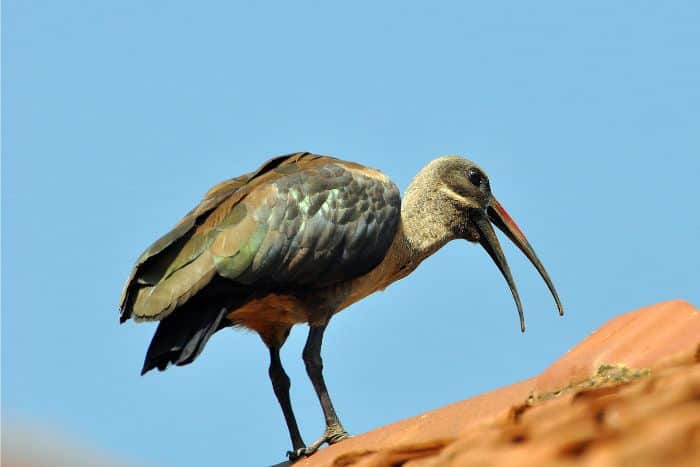
This bird has adapted remarkably well to the urban sprawl. You might see it foraging on lawns or strutting confidently in public parks.
The iconic call, a loud ‘haa-haa-de-dah’, is unmistakable in the early hours—a natural alarm clock that signals sunrise. And I sure swore a few times when hearing their calls way too early on holiday in South Africa 🙂
The Hadada Ibis (Bostrychia hagedash) is native to sub-Saharan Africa. It is commonly found in various habitats such as savannas, grasslands, wetlands, and cultivated areas. Its range includes countries such as Ethiopia, Kenya, Tanzania, Uganda, Zambia, Zimbabwe, South Africa, and others in the region.
7. The Red-eyed Dove: Melody Among the Canopies
Description:
- The Red-eyed Dove ( Streptopelia Semitorquata), distinguished by its soft gray feathers, subtle pink-hued neck, and characteristic crimson eyes, is both elegant and understated.
- This Dove typically measures around 25 to 30 centimeters (10 to 12 inches) in length from head to tail and its weight is usually between 100 to 170 grams (3.5 to 6 ounces).
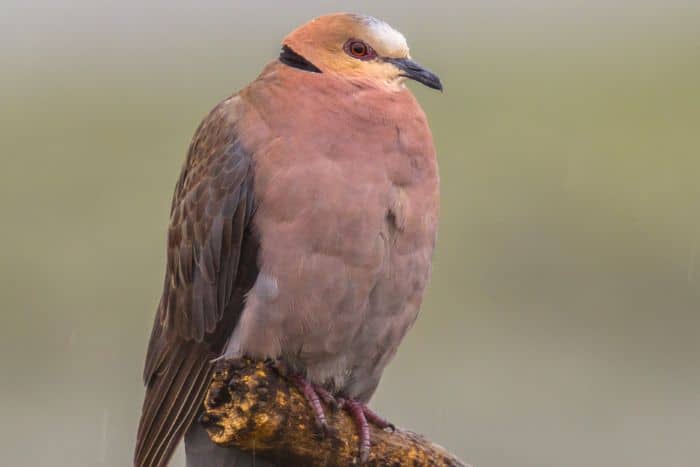
Spotting this bird might require a keen eye, but their call is unmistakable: a rhythmic ‘coo-coo’ that seems to recite the stillness of the morning air.
As dwellers of canopies, these birds prefer the leafy confines of both exotic and indigenous trees, making suburbia an ideal habitat. Your garden likely plays a role in the life of these birds without you even realizing it.
8. The Olive Thrush: The Garden Custodian
Description:
- Its olive-brown back and rufous underparts provide perfect camouflage amidst the undergrowth.
- Olive Thrushes ( Turdus Olivaceus ) typically measure around 20 to 25 centimeters (8 to 10 inches) in length and they usually weigh between 70 to 90 grams (2.5 to 3.2 ounces).

The Olive Thrush, a bird so common in Southern Africa yet so integral to the health of our garden ecosystems. In its daily quest for nourishment, it helps control insect populations, a natural pest control if I may say so.
Beetles, earthworms, and other invertebrates often fall prey to their sharp-eyed foraging, which, in turn, promotes plant health and saves our precious greenery from potential damage.
This bird is native to southern Africa. Its range includes countries such as South Africa, Lesotho, Swaziland, Namibia, Botswana, Zimbabwe, Mozambique, and southern parts of Zambia. It is commonly found in forests, woodlands, gardens, and parks throughout its range.
9. The Spotted Thick-Knee: A Nocturnal Watchman
Description:
- Standing at about 40-45 cm tall, the Spotted Thick-Knee is an interesting sight.
- Its feathers are mottled brown, providing excellent camouflage against the dry grasses it calls home. The characteristic ‘Thick-knee’ refers to the prominent joints on its long, slender legs, an adaptation for its life on the ground.

The Spotted Thick-Knee, also known by its scientific name, ‘Burhinus capensis’, is a gifted nocturnal predator, playing a significant role in the balance of ecosystems. As the sun fades, Thick-Knees become active, using their keen eyesight to hunt for insects, spiders, and other small creatures.
You may encounter the Spotted Thick-Knee across various Southern African countries, from open plains to scrublands and even urban parks and golf courses.
A fascinating aspect of the Spotted Thick-Knee’s behavior is its nesting habits. They lay their eggs in simple scrapes on the ground, trusting their exceptional camouflage to protect their future offspring.
10. The Southern Masked Weaver: Master Architect of the Savannah
Physical description:
- Small to medium-sized bird with striking yellow plumage on males during breeding season.
- Height: Typically measures around 12 to 15 centimeters. Weight: Adults generally weigh between 20 to 30 grams.
- Colors: Males sport vibrant yellow plumage with a black face mask during breeding season, while females and non-breeding males have more subdued brownish plumage.
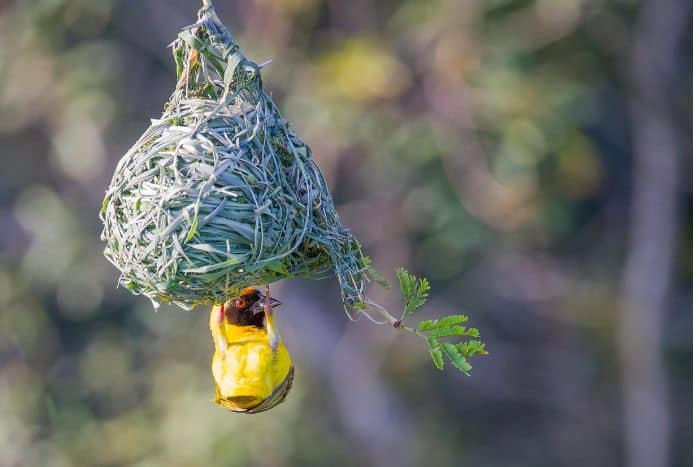
The Southern Masked Weaver (Ploceus velatus) is a master artisan of the African savannah, renowned for its meticulously woven nests suspended from the branches of thorn trees.
During the breeding season, male Southern Masked Weavers transform into dazzling avian architects, adorning themselves with vibrant yellow plumage to attract potential mates.
With remarkable dexterity, they construct elaborate nests using strips of grass, leaves, and other plant materials.
The Southern Masked Weaver (Ploceus velatus) is primarily found in sub-Saharan Africa, inhabiting a wide range of habitats including savannas, woodlands, grasslands, and scrublands. Its range extends from South Africa, Namibia, Botswana, Zimbabwe, and Mozambique, northwards to Angola, Zambia, Malawi, Tanzania, Kenya, and Uganda.
11. The African Fish Eagle: Iconic Raptor of African Waterways
Physical description:
- The African Fish Eagle is a large raptor with striking plumage and a distinctive white head.
- Its height typically measures around 63 to 75 centimeters and its wingspan can reach up to 2.4 meters. Weight: Adults generally weigh between 2.4 to 3.6 kilograms.
- Colors: Dark brown plumage with a white head and tail, yellow beak, and piercing yellow eyes.

The African Fish Eagle (Haliaeetus Vocifer) commands attention with its majestic presence along the waterways and lakeshores of sub-Saharan Africa.
With a wingspan stretching up to 2.4 meters, they are powerful and agile hunters, renowned for their prowess in catching fish from the water’s surface.
The iconic call of the African Fish Eagle, a resonant and melodious cry that echoes across the African wilderness, adds to its aura of regal authority. This distinctive vocalization serves not only as a territorial proclamation but also as a hauntingly beautiful soundtrack to the African landscape.
From South Africa’s Kruger National Park, various river systems like the Limpopo, and Orange Rivers, as well as lakes such as Lake St. Lucia and Lake Sibaya to the shores of the mighty Zambezi River to Kenya’s Rift Valley lakes, the African Fish Eagle reigns supreme as a symbol of strength, freedom, and the untamed beauty of Africa’s aquatic habitats.
12. The Southern Red Bishop: Flamboyant Feathered Firebrand
Physical description:
- The Southern Red Bishop is a small songbird with vibrant plumage, especially during breeding season.
- Their height typically measures around 11 to 14 centimeters and their weight is generally between 15 to 30 grams.
- Colors: Males display bright red plumage on the crown, throat, and breast during the breeding season, while females and non-breeding males have more subdued brownish plumage.
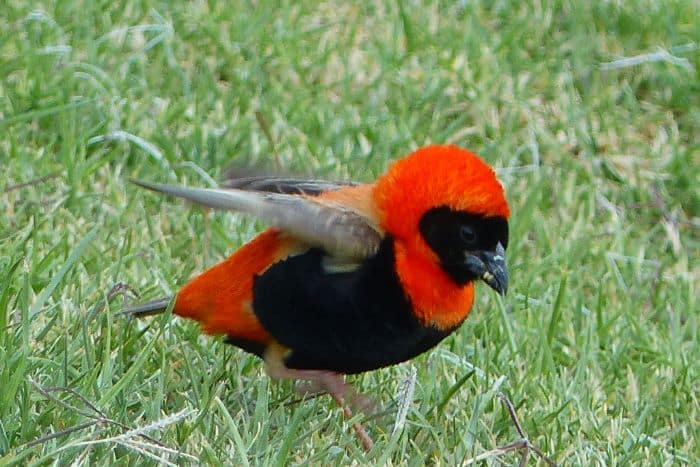
The Southern Red Bishop (Euplectes orix), a diminutive yet flamboyant resident of South Africa’s grasslands and wetlands, adds a splash of vibrant color to its surroundings with its striking plumage and energetic displays.
During the breeding season, male Southern Red Bishops undergo a dramatic transformation, donning rich crimson plumage on their crowns, throats, and breasts. Their bold colors serve as beacons of attraction, drawing the attention of potential mates and rival males alike.
With a repertoire of chirps, trills, and warbles, these charismatic songbirds fill the air with their melodious calls, adding a cheerful soundtrack to the grassy meadows and reed beds they call home.
But it’s not just their appearance and vocal prowess that make Southern Red Bishops stand out; they are also accomplished weavers, constructing intricately woven nests from grass and other plant materials.
From the lush wetlands of the Western Cape to the open grasslands of the Free State, the Southern Red Bishop’s vibrant presence adds an extra layer of beauty to the South African landscape, making it a beloved symbol of vitality and color in nature.
13. The Cape Robin-Chat: Melodious Minstrel of the Garden
Physical description:
- The Cape Robin-Chat is a small to medium-sized bird with subtle yet handsome plumage.
- Height: Typically measures around 16 to 18 centimeters and its weight: Adults generally weigh between 18 to 25 grams.
- Colors: Rich brown upperparts with a white belly, orange-red breast, and a distinct white eye-ring.
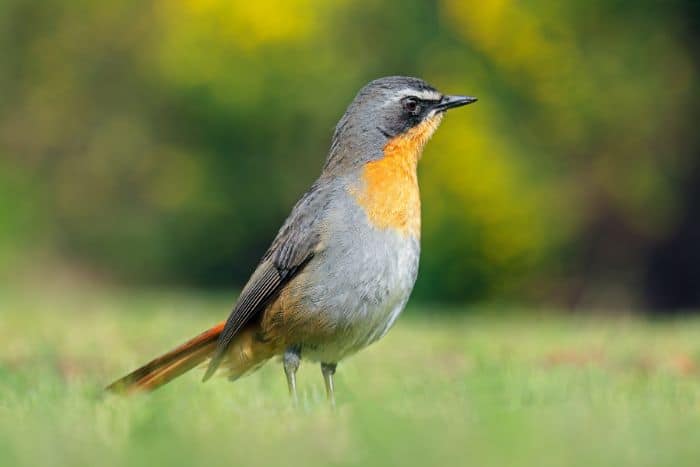
The Cape Robin-Chat (Cossypha Caffra), a charming songster of South Africa’s gardens and woodlands, enchants listeners with its sweet melodies and graceful presence.
Despite its unassuming appearance, the Cape Robin-Chat possesses a voice that belies its size, filling the air with a melodious song that echoes through the trees and shrubs. Its repertoire includes a variety of whistles, trills, and warbles, each delivered with precision and clarity.
These adaptable birds are equally at home in urban gardens as they are in natural woodlands, bringing joy to birdwatchers and nature enthusiasts alike with their cheerful presence and beautiful music.
From the lush forests of the Garden Route to the suburban landscapes of Cape Town, the Cape Robin-Chat is a cherished companion in South Africa’s outdoor spaces.
Want to find the best binoculars for a safari? Check out my blog post here!
14. The African Hoopoe: Crowned Herald of the Dawn
Physical description:
- The Hoopoe bird is a medium-sized bird with distinctive plumage and a prominent crest.
- Height: Typically measures around 25 to 30 centimeters and their weight is generally between 46 to 89 grams.
- Colors: Rich chestnut plumage with black and white markings, prominent black and white striped wings, and a long, slender curved beak.
- They have a distinctive crest on its head. This crest is particularly prominent and can be raised or lowered by the bird depending on its mood or level of alertness. The crest adds to the bird’s striking appearance and is one of its most recognizable features.
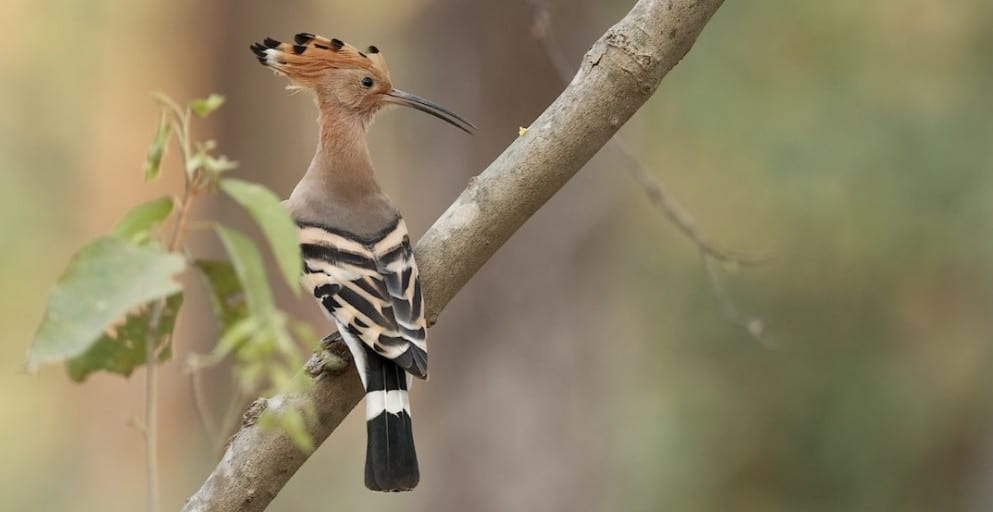
The African Hoopoe (Upupa africana), with its striking appearance and unmistakable call, heralds the dawn with regal grace and elegance across the savannahs and woodlands of South Africa.
Perched atop a tree branch or probing the ground for insects with its long, slender beak, the African Hoopoe cuts a distinctive figure with its prominent crest.
As the first light of dawn breaks across the landscape, the African Hoopoe announces its presence with a series of melodious calls, resembling the sound “hoop-hoop-hoop” or “oop-oop-oop,” echoing through the trees and signaling the start of a new day.
The African Hoopoe has an unusual trait though—it emits a strong, musky odor, often described as unpleasant or even offensive. This odor is produced by a secretion from the preen gland located at the base of the tail.
15. The Southern Red-billed Hornbill: Charismatic Sentinel of the Savanna
Physical description:
- The Southern Red-Billed Hornbill is a medium-sized bird with striking plumage and distinctive bill.
- Height: Typically measures around 42 to 50 centimeters and its weight is between 119 to 230 grams.
- Colors: Black plumage with white markings on wings and tail, vibrant red bill, and bare skin around the eyes.

The Southern Red-billed Hornbill (Tockus Rufirostris) commands attention with its charismatic presence and distinctive appearance as it surveys the savannas and woodlands of South Africa.
With a keen eye for insects, small reptiles, and even small mammals, the Southern Red-billed Hornbill plays an important role in controlling pest populations and maintaining the balance of its ecosystem. Its bill, adapted for grasping and manipulating prey, is a formidable tool in its quest for food.
During the breeding season, these sociable birds form monogamous pairs and work together to build their nests in natural cavities or abandoned tree holes. The female seals herself inside the nest cavity using a mixture of mud, saliva, and droppings, leaving only a small opening through which the male can pass food to her and their offspring.
From the sun-drenched plains of the Kruger National Park to the acacia-studded landscapes of the Kalahari Desert, the Southern Red-billed Hornbill stands as a symbol of resilience and adaptability in the face of Africa’s ever-changing environments.
16. The African Sacred Ibis: Ancient Guardian of the Nile
Physical description:
- The African Sacred Ibis is a medium-sized wading bird with distinctive plumage and a long bill.
- Height: Typically measures around 65 to 75 centimeters. Weight: Adults generally weigh between 1 to 1.5 kilograms.
- Colors: White plumage with glossy black feathers on the wings, long black legs, and a curved black bill.

The African Sacred Ibis (Threskiornis Aethiopicus) evokes a sense of timeless mystique as it gracefully traverses the wetlands and riverbanks of South Africa, harkening back to ancient civilizations and their reverence for this noble bird.
Adorned in pristine white plumage accented by glossy black feathers on its wings, the African Sacred Ibis embodies purity and elegance in its appearance. Its long, slender bill is perfectly suited for probing the muddy shallows in search of aquatic prey, including fish, frogs, and insects.
It is often found in large flocks, where its communal roosting and nesting behaviors serve as a testament to its social nature.
In ancient Egyptian mythology, the African Sacred Ibis held a revered status, symbolizing wisdom, protection, and fertility. Depicted in hieroglyphs and temple reliefs, it was believed to be a guardian of the Nile and a messenger of the gods.
17. The Southern Grey-headed Sparrow: Cheerful Chatterbox of the Bushveld
Physical description:
- Small bird with subtle yet charming plumage.
- Height: Typically measures around 14 to 15 centimeters. Weight: Adults generally weigh between 20 to 28 grams.
- Colors: Grey head with brownish upperparts, pale underparts, and a distinctive black bib.
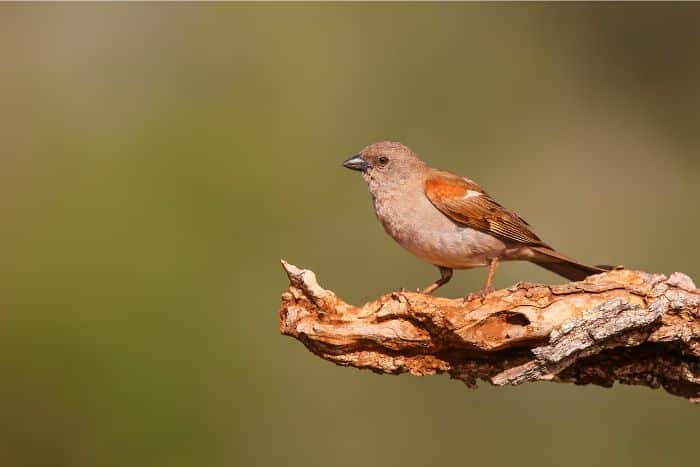
The Southern Grey-headed Sparrow (Passer diffusus) is like the friendly neighbor you always love to see, hopping about with boundless energy in the bushveld of South Africa.
With its unassuming grey head and brownish feathers, this little bird might not catch your eye at first. But spend some time watching its antics, and you’ll be captivated by its charm.
But here’s the best part – these sparrows are absolute chatterboxes! They fill the air with a cheerful cacophony of chirps, tweets, and trills, as if they’re having the most exciting conversation of their lives. It’s like a non-stop party in the bushveld, and everyone’s invited!
From the bustling suburbs to the tranquil countryside, the Southern Grey-headed Sparrow is a beloved companion, bringing joy and liveliness to every corner of South Africa’s landscapes.
18. The African Jacana: Graceful Stilt-Walker of the Wetlands
Physical description:
- Medium-sized wader bird with distinctive long legs and toes.
- Height: Typically measures around 25 to 30 centimeters. Weight: Adults generally weigh between 110 to 140 grams.
- Colors: Brown plumage with black-and-white markings on wings and body, long yellow legs, and elongated toes with large, flattened claws. It has a distinctive blue patch on its head, which adds to its striking appearance. This patch is often visible on both males and females, and it contrasts beautifully with the bird’s brown plumage
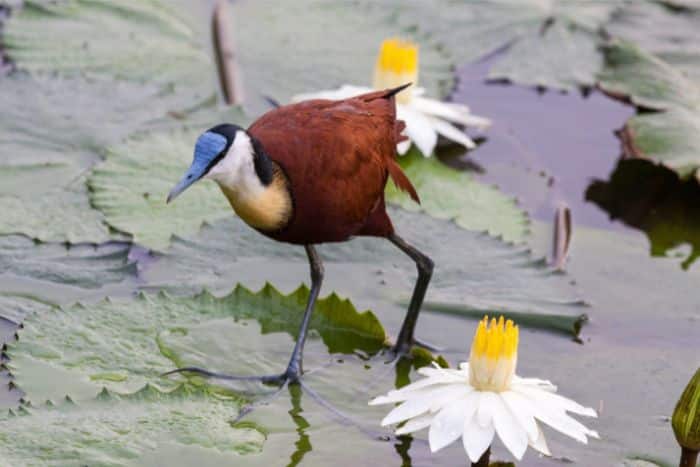
Meet the African Jacana (Actophilornis africanus), the ultimate stilt-walker of South Africa’s wetlands. With its long, slender legs and toes that seem to defy gravity, this bird is a true master of balance and elegance.
Picture this: a serene wetland landscape dotted with lily pads and reeds, and there, gracefully gliding across the water’s surface, is the African Jacana.
The African Jacana uses the long legs to navigate the maze of aquatic vegetation, delicately stepping from one floating leaf to another as if walking on water. And those large, flattened claws? They’re like built-in flotation devices, helping it stay afloat and stable in even the most precarious positions.
As if that weren’t impressive enough, the African Jacana is also a devoted parent. During breeding season, the males take on the role of primary caregivers, incubating the eggs and caring for the chicks while the females go off in search of new mates.
19. The Pied Crow: Bold Avian Opportunist of the Urban Jungle
Physical description:
- Medium-sized crow with distinct black and white plumage.
- Height: Typically measures around 40 to 46 centimeters. Weight: Adults generally weigh between 300 to 600 grams.
- Colors: Glossy black plumage with white markings on the chest, belly, and wing feathers.

Say hello to the Pied Crow (Corvus albus), a savvy and adaptable bird that thrives amidst the hustle and bustle of South Africa’s urban environments.
With its glossy black feathers and bold white markings, the Pied Crow cuts a striking figure against the cityscape. From scavenging for scraps in crowded markets to perching on lampposts and rooftops, this opportunistic bird knows how to make the most of its surroundings.
But don’t let its urban lifestyle fool you – the Pied Crow is equally at home in rural areas, where it can be found foraging for insects, small mammals, and carrion in open fields and grasslands.
One of the most fascinating things about the Pied Crow is its intelligence and adaptability. It’s not afraid to take risks and explore new opportunities, whether it’s raiding bird feeders or stealing food from unsuspecting picnickers.
My Final Conclusion.
I’ve introduced you to just a glimpse of the birdlife that thrives across the diverse landscapes of Southern Africa. From the community-loved weavers to the awe-inspiring peregrine falcon, each bird carries a unique story.
Whether you’re an ornithologist, a birdwatching enthusiast, or simply someone who respects the beauty of nature, understanding these common birds is a step towards appreciating the natural world around us.
If you have any more questions about this list of most common birds in Southern Africa, please feel free to leave them down below in the comment section or join me on my social media channels for more pictures, videos and stories about my African adventures 🙂
I wish you happy travels and birdwatching!
Kind regards,
Lizzy
I now have a YouTube channel as well!
YouTube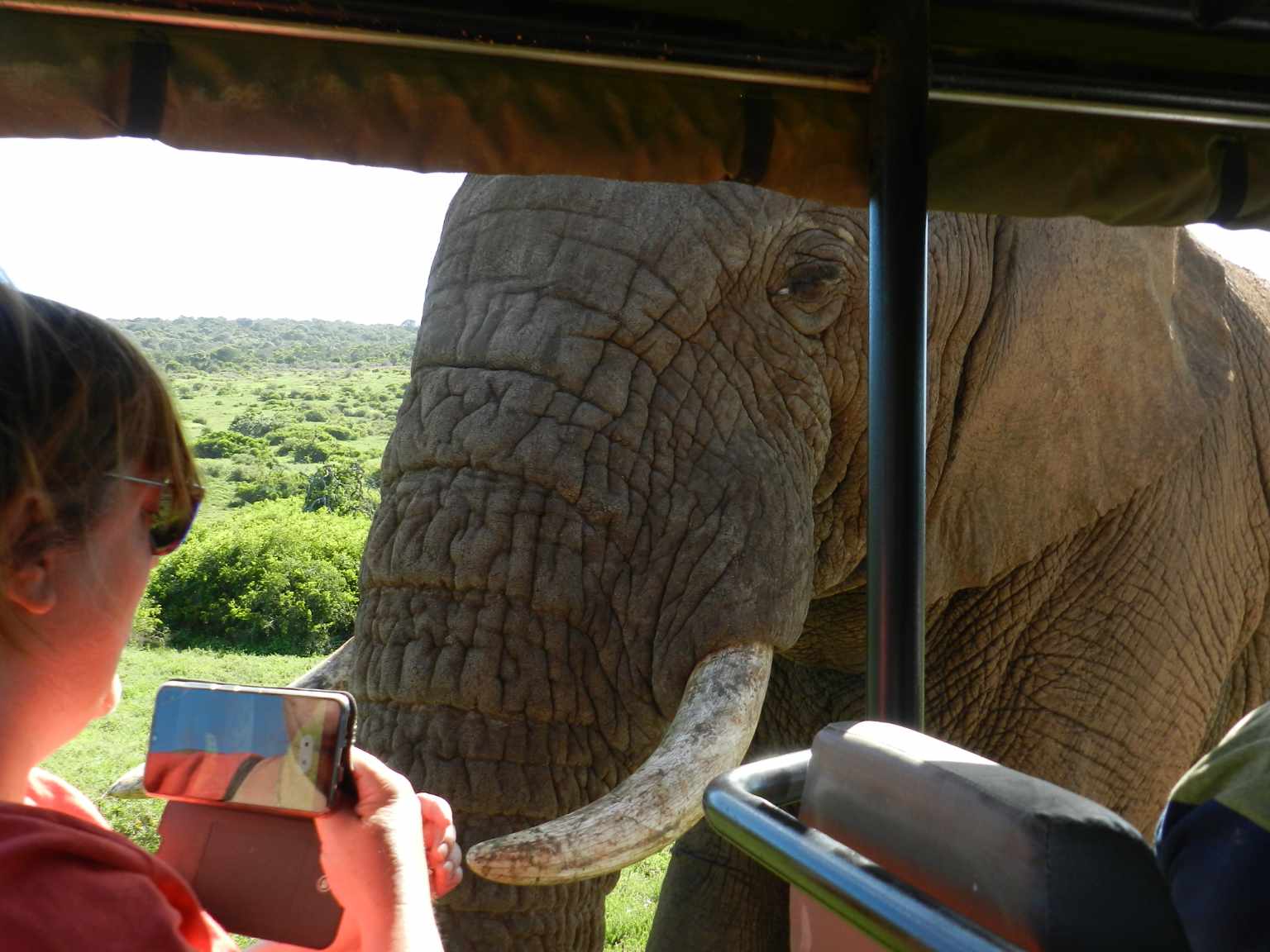
Hello Africa travellers!
Who am I? Well, the least you can say is that I am quite crazy about Africa, its nature, its climate, its culture, and more.
As a young woman in my twenties, I had already traveled to several African countries by traveling along in an overlander on my own and mostly camping ( or glamping ) and just fell in love with the diversity of it all.
So much, so that at the age of 26, I went back to university to study biology, which, unfortunately, I couldn’t finish because of health reasons (yes, I got sick from a tropical disease, oh cynicism). But this did not stop my dream of traveling back to Africa several times, and I still do.
My dream was back then to leave Europe and go study animal behavior, especially the elephants (sure, that’s every girl’s dream haha), but I am also very much intrigued by hyenas and other “ugly African animals“.
So, I “kind of” have a little bit of a scientific approach to my articles, when I write about African birds, for example. And most of all: the passion.
But life goes on, you move from one side of the country to the other, you get sick again and top it off with lower back problems, and before you know it, you are over 50 hahaha!
Now, I still travel to Africa, but take it a bit “easier” than the good old camping days, and stay in comfortable, yet affordable accommodations, together with my husband Wouter.
These are some of the countries I have traveled to: Kenya, Tanzania, Zanzibar, Malawi, Zambia, Zimbabwe, South Africa, Namibia, Botswana, Tunisia, and a little bit of Lesotho LOL .
While clearly not being African territory, but Spanish, I also visited Gran Canaria and Tenerife, and location-wise, I consider them “African”, because of their climate and nature, sue me :-p
The last trip I took was to South Africa in the year 2023, and it sure got the fevers for Africa back! From the Barberton mountains to the Drakensberg and the Southcoast, one month wasn’t enough at all to see the whole country, so we’ll be back! At ease and with a little bit more luxury than in my younger days haha!
I wish you happy travels!
Kind regards
Lizzy

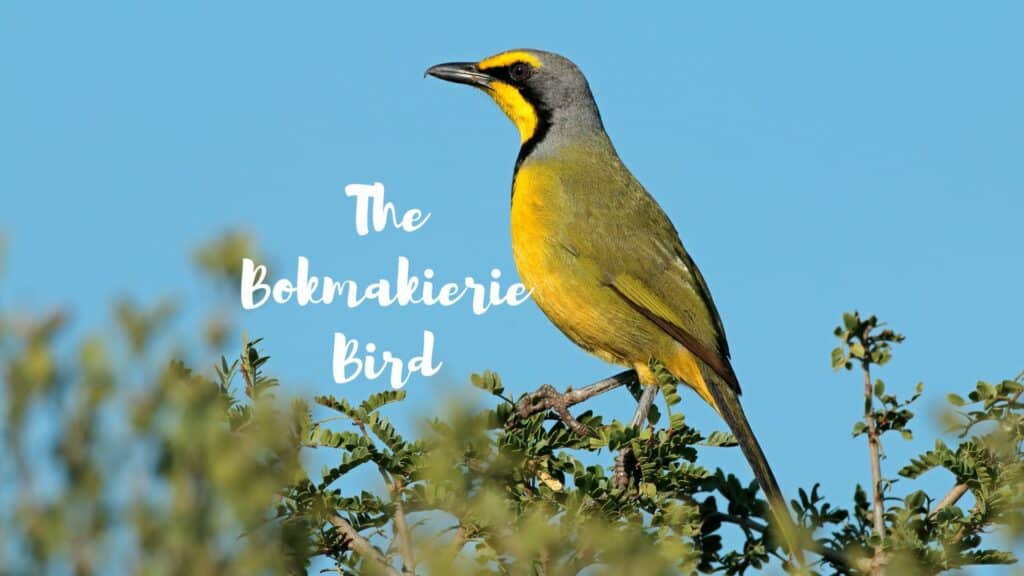
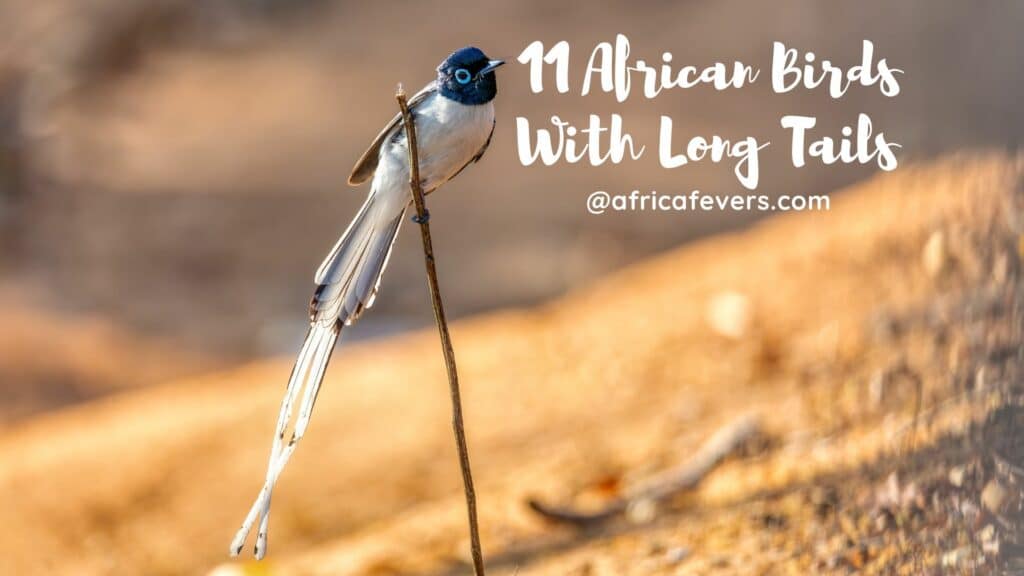
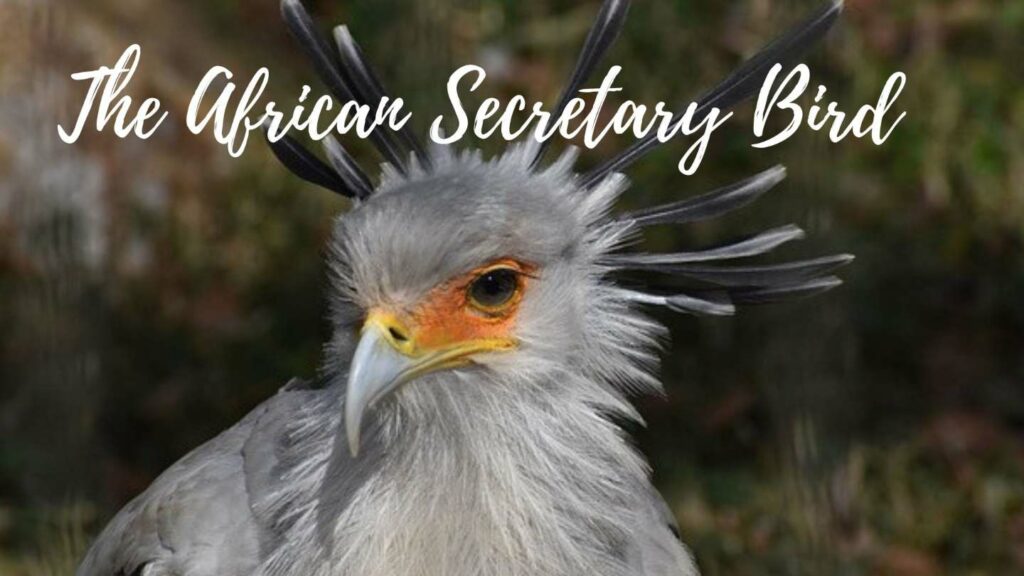
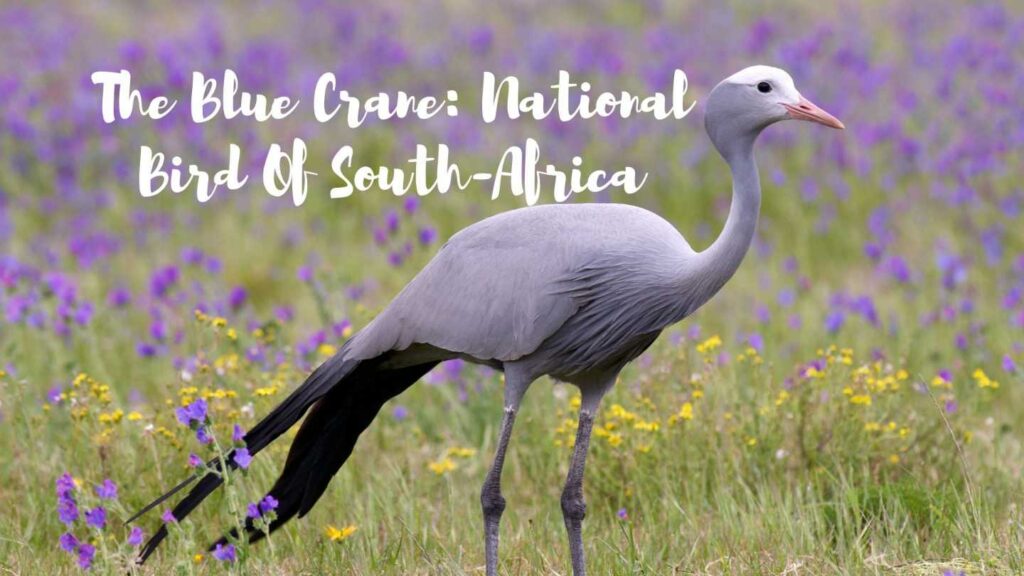


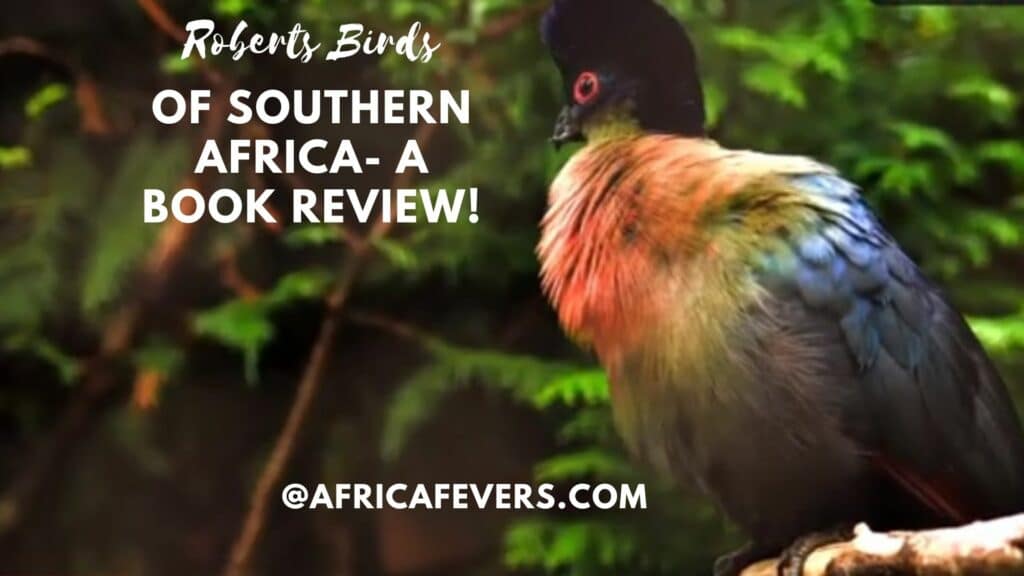
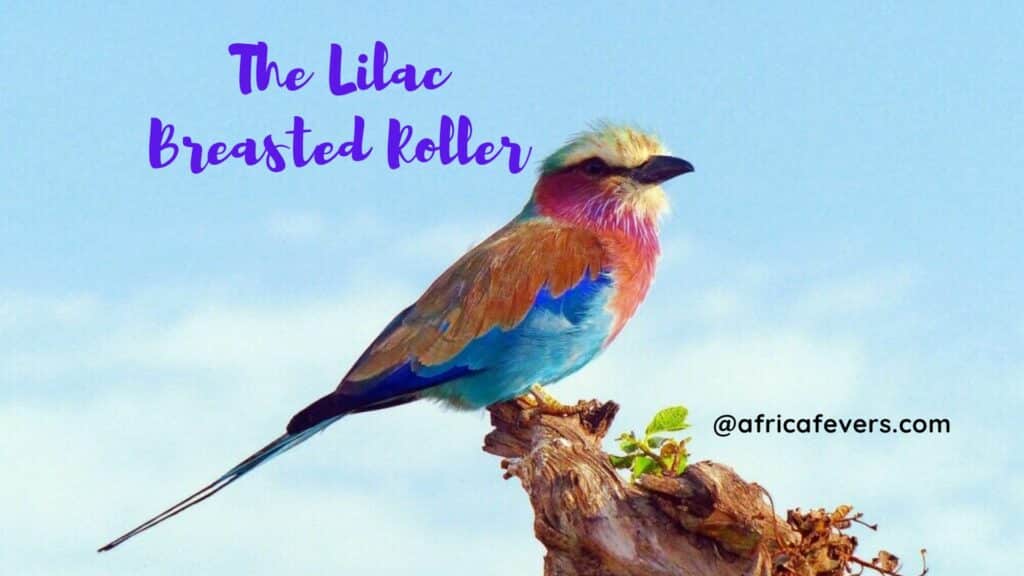
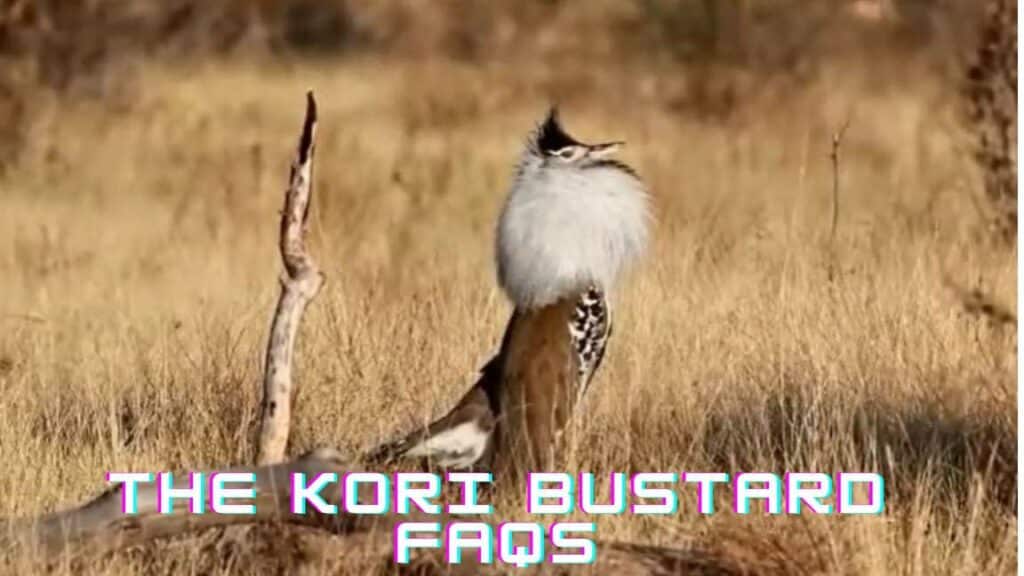
what an incredible and comprehensive list of the most common birds in Southern Africa! This article is not only informative but also beautifully written, highlighting the diverse avian life that graces this stunning region. From the iconic African Fish Eagle to the charming Cape Robin-Chat, each bird is portrayed with such vivid detail, making me feel like I’m right there in the heart of the savannah or woodland.
I particularly appreciate the inclusion of physical descriptions, photos, and fascinating facts about each bird, which adds depth to the narrative and enhances my understanding of these magnificent creatures. It’s evident that a lot of research and passion went into compiling this list, and I’m grateful for the opportunity to learn more about the avian wonders of Southern Africa.
The concluding remarks tie everything together perfectly, emphasizing the importance of appreciating and understanding the natural world around us. As an avid birdwatcher, I found this article to be both educational and inspiring, and I can’t wait to embark on my own African adventures armed with this newfound knowledge.
Thank you, Lizzy, for sharing your expertise and passion for birds with us. I look forward to reading more of your captivating stories and insights in the future. Keep up the fantastic work!
what an incredible and comprehensive list of the most common birds in Southern Africa! This article is not only informative but also beautifully written, highlighting the diverse avian life that graces this stunning region. From the iconic African Fish Eagle to the charming Cape Robin-Chat, each bird is portrayed with such vivid detail, making me feel like I’m right there in the heart of the savannah or woodland.
I particularly appreciate the inclusion of physical descriptions and fascinating facts about each bird, which adds depth to the narrative and enhances my understanding of these magnificent creatures. It’s evident that a lot of research and passion went into compiling this list, and I’m grateful for the opportunity to learn more about the avian wonders of Southern Africa.
The concluding remarks tie everything together perfectly, emphasizing the importance of appreciating and understanding the natural world around us. As an avid birdwatcher, I found this article to be both educational and inspiring, and I can’t wait to embark on my own African adventures armed with this newfound knowledge.
Thank you, Lizzy, for sharing your expertise and passion for birds with us. I look forward to reading more of your captivating stories and insights in the future. Keep up the fantastic work!
Hi Bernard!
How beautiful your reaction is, thank you! I will of course share more of my African birds passion soon, thanks for the motivational speech haha!
( but first, we will talk about something more adventurous: white water rafting, see you soon haha!)
Lizzy
Penguins in Africa? That’s truly surprising! I always believed encountering penguins meant journeying to the ends of the earth and braving freezing temperatures. It’s fascinating to learn that these charming creatures also call Southern Africa home. It’s so sad to hear that they’re endangered. 🙁 Let’s hope for a positive change in their situation soon.
Hello!
Yes, they are right there in South Africa haha, surprise! 🙂
thanks for visiting!
(and yes, I hope so too, let’s try to protect them!)
Lizzy